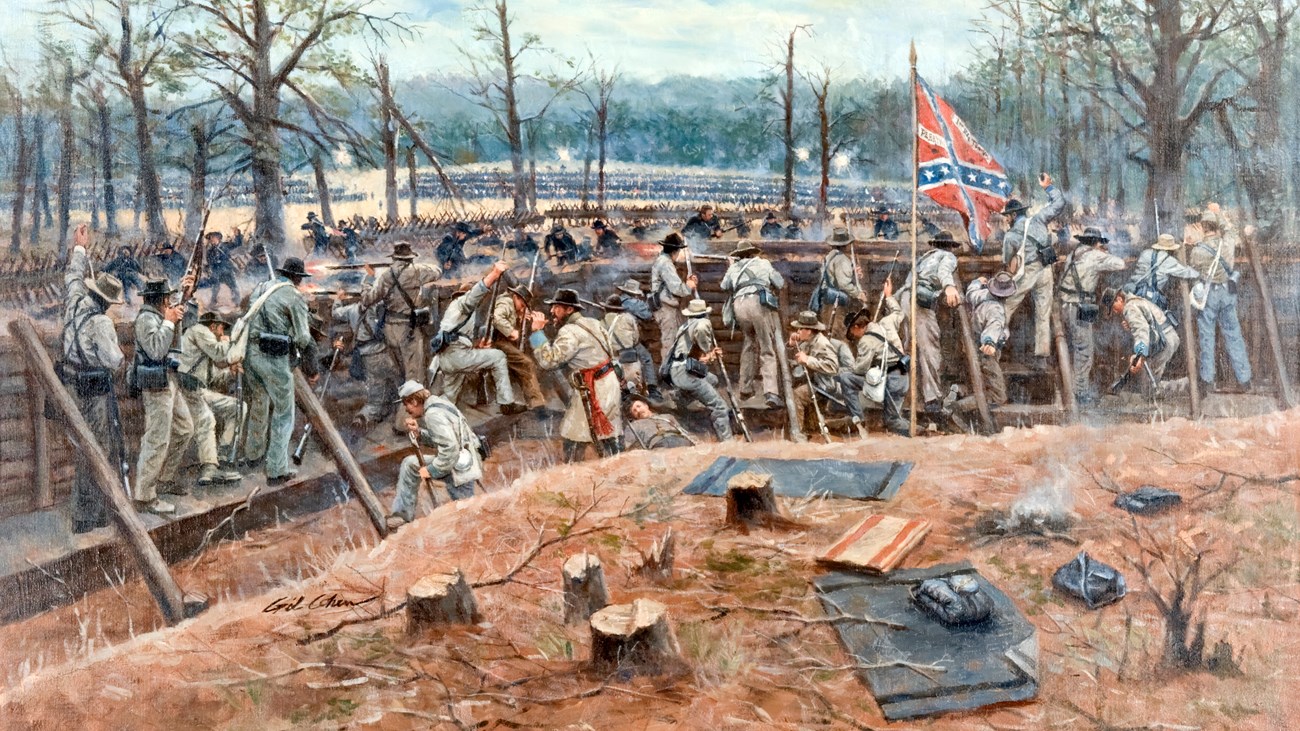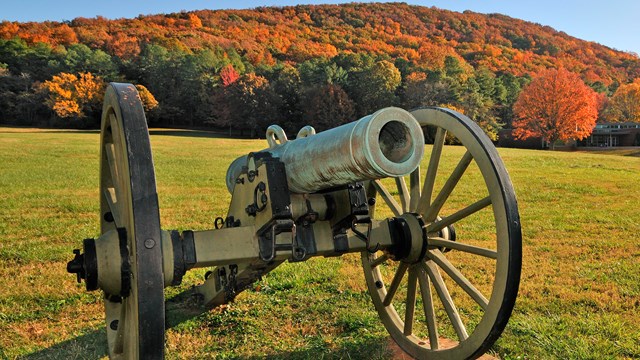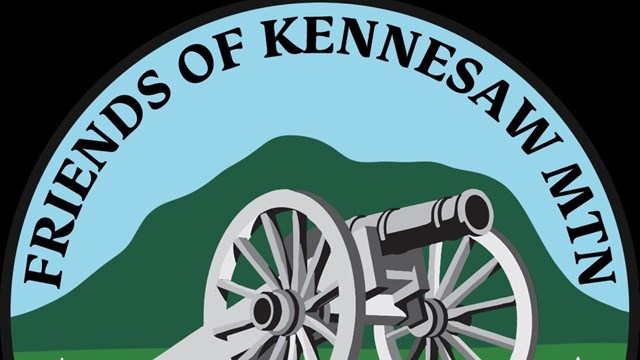"May God hasten the day when this cruel war will be brought to a close so that our nation may enjoy peace once more.
But we must remember that there may be many men yet who will still fall for their country. May God be with us and help us as we stand in need." Sergeant Alexander Downing, 11th Iowa.
In three years of civil war, it is just the latest numbing episode of horrific slaughter. At Pickett's Mill, in the woods of northern Georgia, more than 1400 Union soldiers have been killed , wounded or captured. A confederate cavalryman was witness to the slaughter. "Some 12 hours earlier, the enemy could not see our men until they were in about 20 yards. I doubt that there was ever at any time during the war as many men killed by so small a force as we had there that day."
The Union debacle at Pickett's Mill is just the latest fight in a crucial campaign that many believe will determine the outcome of the civil war.
General William Tecumseh Sherman has been ordered to lead his 100 000 man army south from Chattanooga, Tennessee. Sherman's orders are "to get into the interior of the enemy's country as far as you can, inflicting all the damage you can against their war resources."
His mission: Capture Atlanta, some 100 miles south, a manufacturing center and industrial hub of the confederate war machine. Its four railroad lines bind together what is left of the confederacy. For the union to achieve final victory, Atlanta and the confederate army defending it must be destroyed.
In Sherman's way is an army of more than 60,000 men led by General Joseph Johnston . Johnston knows that the very future of the confederacy depends on saving Atlanta.
For the past month, Sherman and Johnston have been waging a deadly game of chess.
Time and again Sherman has tried to outflank the confederate army. Each time his moves have been checked by Johnston.
But in the process, the confederate general has been forced to yield precious ground. By mid-June 1864, Johnston's army is backed up to within 30 miles of Atlanta
Sherman's march brings more than just blue coats into the deep south. It also brings freedom to thousands of slaves.
Austin Gilmore, of Pulaski, Tennessee is hired as a camp cook with 111th Illinois infantry.
Emma Stevenson, a freed slave from Kentucky becomes a nurse with the 17th army corps
And yet the man responsible for emancipating Emma, Austin, and thousands of other slaves, is himself under siege. The 1864 presidential election is less than six months away and Abraham Lincoln's prospects for a second term are dwindling by the day. Despite major victories at Gettysburg and Chattanooga the carnage of three years of war has many angry northerners demanding an immediate peace settlement with the south. A growing radical element within Lincoln's own republican party fear the president's reelection will be fatal to the country. Horace Greeley, the influential editor of the New York Tribune writes "Mr Lincoln is already beaten. He cannot be elected and we must have another ticket to save us from utter overthrow." On June 7th, Lincoln accepts his party's nomination, but it is hardly a ringing endorsement. Despite intense political pressure to settle for peace, Lincoln firmly believes the union cannot be restored until total victory is achieved. By the summer of 1864, this much is certain: the campaign for Atlanta may not only decide the election it, very well could decide the fate of two nations.
In the confederate Army of Tennessee, Sherman faces a determined, even desperate foe. Many fervently believe victory and southern independence can still be theirs.
At every opportunity Johnston's men build miles of makeshift fortifications. The construction is so labor-intensive that the confederates lease slaves from their owners to perform the backbreaking work. For the confederates outnumbered almost two to one , the massive log and dirt earthworks provide a formidable defense against the attacking yankees. "One good man behind earthworks" writes an officer, "should prevail over four or five opponents advancing in the open without cover"
The federals reluctantly respond with defenses of their own. They hire freedmen at ten dollars a month to help with construction.
Often the opposing earthworks lie within mere yards of each other. Between battles life in the trenches is a combination of boredom and bloodshed.
Sergeant johnny green of the 9th Kentucky infantry ,"Anyone who shows his head above the trenches is sure to have two or three minie balls come singing around his ears. But we soon got so accustomed to it, that the boys grew very careless."
[soldier]"Keep your hands down gentlemen!"
For three years, the men in the trenches have fought one another at places like Shiloh, Chicamauga, and Chattanooga. [chaplain]"Pray with me lord, I pray that each man here would repent of his sin. Our father who art in heaven.."(prayer fades) these combat veterans have more in common than the battlegrounds they have fought over. Private Chauncey H Cook of the 25th Wisconsin,: "It seems too bad that we have to fight men that we like." [chaplain continues to pray] "time to be born and a time to die"(prayer fades) [Chauncey] "now these southern soldiers seem just like our own boys only they are on the other side. They talk about their mothers and fathers and their sweethearts just as we do among ourselves"
[chaplain prays] "in the name of Jesus Christ, our lord and savior, I pray, amen."
Caught in the crossfire in the campaign for Atlanta, are the people of Cobb County, Georgia,
population 14,000.
About one-third of those are slaves.
The area was Cherokee land settled in the 1830s by pioneers from South Carolina and Virginia who cleared the forests for farm fields.
Most living around Kennesaw Mountain are not wealthy plantation owners but yeoman farmers who cannot afford to own slaves. Lucinda Casey is a widow who has struggled to keep the family farm while raising three children.
[Lucinda] "Louisa, will you help her please" As Sherman's army approaches, Lucinda and daughters Louisa, Nancy, and Hazeltine hastily packed their belongings and leave their home behind. Like the Casey's, most residents of Cobb County flee to the safety of Atlanta. But a determined few remain to protect their property.
In June ,1864 more than 100, 000 union and confederate soldiers ravage Cobb County.
At Lucinda Casey's home, nothing is spared. it is the same story for most of the other homes in the path of the two armies [soldiers shouting]
Sherman writes "To realize what war is, one should follow our tracks"
By mid-June, Sherman's army has moved within striking distance of his objective. Only one last mountain remains between Sherman and Atlanta. Kennesaw Mountain is over 1800 feet high and two miles long. Some call it the Gibraltar of Georgia. For Johnston, Kennesaw's rocky ridges are the ideal place to halt Sherman.
The summit is a 700-foot precipice called Big Kennesaw. To the south is a spur named Pigeon Hill. Further south is a ridge soon to be known as Cheatham Hill.
With an imposing seven-mile line of defense the confederates will dare Sherman to attack. Just 20 miles beyond Kennesaw Mountain is Atlanta. If Sherman is to be stopped, it will have to happen here.
At Kennesaw Mountain, Sherman once again attempts to outflank the confederates. But this time it is the confederates who were on the attack.
Four miles south of Kennesaw Mountain, General John Bell Hood moves 11 000 men to intercept the federals. Hood's maneuver is about to backfire.
Anticipating an attack, General John Schofield
has entrenched his blue coat south of Marietta at a place called Kolb's Farm.
[Rebels yelling]
artillerist Theodore Tracy is with the 19th Ohio Battery:
"The loud yells became fiercer and dashing out in a strong bold front came triple lines of gray coats.
As we saw the skirmish line fall back a few yards under the brow of the slope, we heard the captain's voice above the roar.[Captain] "Fire!' [explosions, gunshots]
[Explosions] [Confederates yelling, screaming]
[Explosion]
[Muskets Firing]
[Theodore Tracy]"Like a tornado falling after volleys were sent, plunging and tearing through the mass lines, strewing the ground with fallen men.
The rebels trembled under the awful fire wavered and then retreated."
Hood's attack however ill-fated, convinces Sherman to make a bold change in strategy. For months, he has tried to avoid battle by outflanking the confederates. Now Sherman realizes he cannot take Atlanta without directly attacking Johnston's army at Kennesaw Mountain. He plans to destroy the confederates with a frontal assault.
In the pre-dawn hours of June 27th union officers receive 'Special Field Orders Number 28'. [officer reading] "Major General Thomas will assault the enemy at any point near his center to be selected by himself"(officer fades out) The assault on Kennesaw Mountain is to begin at 8 a.m.
To Captain James Burkhalter of the 86th Illinois, Sherman's plan for a frontal attack is suicide: "The stupidity of this order is enough to paralyze me. However I obeyed the orders. The role of Judas is more than I can swallow. [officer continues] "By order of Major General W.T. Sherman."
A little after 8 a.m the Battle of Kennesaw Mountain begins. 5,500 federal surge up the steep slopes of Pigeon Hill.
The confederates are at the top entrenched behind huge boulders.
Private Jabez Cannon of the 27th Alabama: "Reported deadly fire into the face of the advancing foe, [gunshots]
[explosions] and at the same time the 12 cannon above us turned loose. Shells and solid shots split the tall pines like bolts of lightning.
On they gallantly pressed forward until the front line was within a stone's throw of our breastworks.
They halted, unable to advance and loathe to retreat."
Sherman has ordered all cooks and musicians to the Kennesaw battlefield to aid the wounded. Unarmed Austin Gilmore attempts to save a union soldier wounded on Pigeon Hill. The former slave is struck in the hip by a minie ball. [gunshot] Yet , Gilmore manages to drag the soldier to safety. The union assault on Pigeon Hill is a disaster. An officer with the 53rd Ohio sums up the fight on Pigeon Hill by saying "The rebels fought with a desperation worthy of a better cause".
Simultaneous to the fight on Pigeon Hill, Sherman launches the other wave of his main attack. It occurs not at Big Kennesaw but two miles south at Cheatham Hill. Here, Sherman hopes his force can punch a hole in the confederate line and split the enemy in two. In one spot, the confederate earthworks protrude at a sharp angle. A defense that will soon earn the name the 'Dead Angle'.
In the woods below Cheatham Hill are 8,000 union soldiers. To embolden his 52nd Ohio, Colonel Dan McCook recites a poem about warriors of ancient Rome, [Col. Dan McCook] "Outspake brave Horatius the captain of the gate, to every man upon this earth death, cometh soon or late. And how can man die better, than facing fearful odds.
For the ashes of your fathers, and the temples of your gods."
To reach the confederate earthworks, the federals must advance across an open field and up a steep incline. It is a 400-yard march into certain death. When the yankees get within 40 yards, the confederates unleash a torrent of lead and iron.
A soldier from Tennessee said "The cannons bellowed like mad bulls. The enemy was severely punished.
They were exposed to flank fire as well as front fire from our lines. The head logs protected us from actual danger, and we delivered our fire with terrible accuracy."
- Colonel George Gordon, 11th Tennessee. Colonel Dan McCook and 1,300 federals run the gauntlet straight towards the 'Dead Angle'. Somehow a handful are able to make it to the confederate earthworks. Ironically, the safest place for union soldiers on Cheatham Hill is just below the earthworks. Confederate rifles in the head logs above cannot point downward at union soldiers just a few feet away. Alongside Colonel Dan McCook is Private Samuel Canterbury of the 86th Illinois. "When I looked up, Colonel Dan was standing on the head log above me. [I said] Colonel Dan for God's sake, get down they will shoot you! He turned partly around and said, 'Damn you, attend to your own business!' Then the gun was fired. [gunshot] Had I not pulled on his coat, I believe he would have fallen inside the rebel works."
At the 'Dead Angle', the Battle of Kennesaw Mountain turns its most savage. If the union can break through the confederate line, the battle can be won. Sam Watkins of the 1st Tennessee infantry: "The yankees seemed very obstinate. They seemed to walk up and take death as if they were wooden men. It was a life and death grapple." Despite the heroic charge the union soldiers are driven back. Yet some of the federal survivors refused to leave Cheatham Hill. Just below the 'Dead Angle', they dig into a fold of the slope. One soldier said "they began to burrow like gophers". The dip in the hill conceals the yankees from the enemy just 30 yards above. Behind the earthworks, the confederates are bloodied and battered. 1st Lieutenant Thomas Maney summed up the confederate defense saying "Stand we must, and stand we did."
Sam Watkins survived the furious assault. "I never saw so many broken down and exhausted men in my life. I was sick as a horse and as wet with blood and sweat as I could be. Our tongues were parched and cracked for water, and our faces were blackened with powder and smoke.
"Our dead and wounded were piled indiscriminately in the trenches. There was not a single man in the company who was not wounded or had holes shot through his hat and clothing."
Over 600 miles away, in Washington D.C., Abraham Lincoln receives the disappointing news of the Battle of Kennesaw Mountain. Despite the defeat, Lincoln remained steadfast that slavery caused the war and must be abolished. With the election just four months away, Lincoln's opponent in the coming election is ,ironically, the former commander of the Army of the Potomac. The democrats nominate George MCclellan. The party's platform calls for a negotiated peace with the confederacy. Privately Lincoln admits he's going to be badly beaten in the coming election. His only hope is for a great turnaround in the war.
Two days after the bloody fight, confederate and union forces remain in a standoff on Cheatham Hill. More than 1,800 union dead litter the battlefield. The corpses rot in 100 degree heat. For some, a fate worse than death is to lie wounded along the confederate earthworks. For more than 48 hours, they lay under the broiling sun with no food and no water. On the morning of June 29th, a white flag is raised near the 'Dead Angle'. It is not flown by union troops but rather by the confederates. Lieutenant Colonel A.L. Fahnestock: "The smell from the bodies was so offensive, but the wind was in our favor. The rebels requested us to cease firing and have an armistice to bury the dead. Slowly and cautiously negotiating parties from both sides
emerge. The officers agree to a two-hour truce. Together, union and confederate soldiers begin the gruesome task of burying the dead. As the putrifying condition of the dead precluded carrying bodies from the field, They were buried where they lay.
It was a sad, mournful undertaking. Many in the details discovered and laid to rest some of their best friends.
There are similar burial ceasefires at other areas on Cheatham Hill. During these truces, there is no war. There are no yankees no confederates. On Cheatham Hill this day, there are only Americans.
[soldier speaking]"It was indeed a strange sight. During the truce all was peace and apparent unity. But as soon as the last sad service the living can render to the dead had been performed,
both sides resume their efforts to kill, and maim, then cripple." Sergeant Henry Alden, 85th Illinois.
On day seven of the standoff at Cheatham Hill, there is an odd silence from the confederate earthworks.
A detachment of union soldiers emerge from their defenses to investigate.
What they find cannot be believed.
Despite achieving a tactical victory, the confederates have not only abandoned Cheatham Hill, But all positions on Kennesaw Mountain.
Sherman's frontal assaults on Pigeon Hill and Cheatham Hill have been disasters. But ironically, a diversionary attack on Johnston's left has established a toehold behind the confederate line. In response, the confederate army falls back towards Atlanta. Johnston believes the natural obstacle of the Chattahoochee River provides a better defense for Atlanta. Sherman once again has the confederates on the run.
After the battle, a union field hospital is set up at the masonic hall in nearby Marietta, Georgia.
One of the nurses caring for the wounded is Emma Stevenson, the emancipated slave from Kentucky. Among the hundreds wounded at kennesaw mountain is Asa Soper of the 30th Illinois. "Mother, I take my pen in hand to write you a few lines. I hope you are well. I am in a building and dry. The few nurses here work all day and night. We have a slave woman who cares for us on this floor. She has kindness and treats us with tender care.
But my only hope is to come home to you."
[signed] Asa
Asa Soper never made it back to Illinois.
He died in Marietta weeks later.
"The very object of war.." Sherman once wrote, "...is to produce results by death and slaughter."
The killed and wounded number 3,000 federals
and 1,000 confederates. Many survivors remembered it as a senseless slaughter of friends and comrades.
The battle's casualties extend far beyond the two armies.
Like a cyclone, the war leaves unimaginable destruction to the homes and farmsteads in its path.
There are no census records of Lucinda Casey and her three daughters ever again living in Cobb County. They and thousands of others are lost to history. For those who did come home, it would take decades for the scars of battle to begin to heal.
Sam Watkins, the soldier from Tennessee who withstood the furious assault on the 'Dead Angle',
somehow survives the war. He returns to the family home in Mount Pleasant, Tennessee and begins penning his experiences in places like Shiloh, Chickamauga, and Kennesaw Mountain.
Watkins' eyewitness accounts will bring the civil war home to future generations of Americans.
Austin Gilmore, the freed slave from Tennessee, dies of the wound he received on Pigeon Hill.
Emma Stephenson, who comforted the wounded in the field hospitals of Sherman's army herself succumbs to disease less than a month after Kennesaw.
Emma and Austin are buried with the honored dead from Kennesaw Mountain. Austin in an unmarked grave.
Though their lives were tragically cut short, Emma and Austin died free. And they died knowing that the end of slavery was no longer just a dream.
Nine weeks after the Battle of Kennesaw Mountain, Sherman wires Washington with stunning news: "Atlanta is ours and fairly won"
The union capture of Atlanta is the great change in the war for which Lincoln had hoped. For the very first time, many in the north now believe victory can be achieved. In November, the president defeats McClellan in a landslide.
Less than a year following the Battle of Kennesaw Mountain, Abraham Lincoln's vision for a reunited nation will finally be fulfilled.




